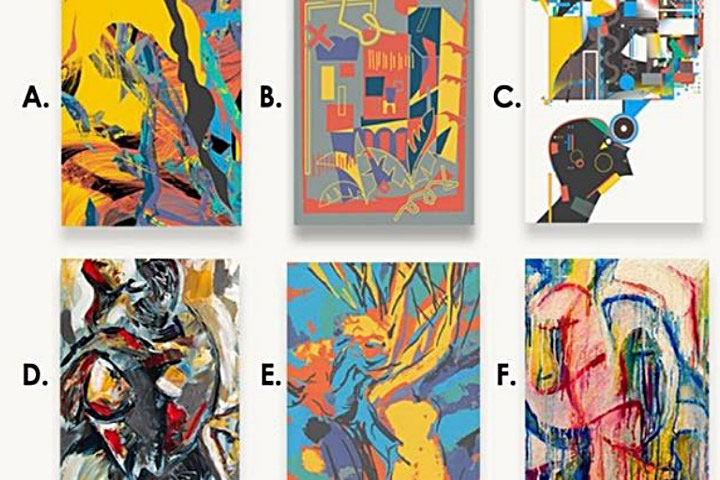Looking at these pictures, can you guess which ones are not made by humans?
Among the 6 pictures below, there are 5 pictures drawn by artists around the world, the other is drawn by a robot . If you can't identify the difference, don't worry, because you're not the only one.
According to Quartz, the paintings are ordered for an experiment by GumGum - an artificial intelligence company based in Santa Monica, and the Art and Artificial Intelligence Laboratory at Rutgers University. Researchers don't have to try to find the answer to the question of whether a machine can simulate a human-like finishing work, but whether a machine can replicate the creative process of a human or not.

Looking at these pictures, what do you think is not a human drawing?
The creative process is what makes art always a unique product of people. For us, art does not stop at the end product; it is also a way for people to share a common experience.
"Machines don't know how to experience the death of a newborn baby, or wait for a new album to come out," - Ben Plomion, GumGum's Marketing Manager, said - "That's why , I don't think artworks created by machines can be warmly received as man-made works. But machines can certainly help people in the creative process. "
All six artists involved in the experiment were asked to draw a picture inspired by a collection of American 20th-century abstract art school. For Cloudpainter - a painting robot developed by pindar van Arman in Virginia - this collection becomes a database for training its algorithms. The finished product that it creates (have you guessed which one? Unveiled is F picture) that is far different from the geometric style with the alternating lines and colors you often imagine when it comes to robot painter. Instead, with random colored drops and blurry pen lines, this work looks surprisingly human.
Of course, like many automation technologies today, standing behind Cloudpainter is still a person. Van Arman created this robot and is responsible for programming software that plays a decisive role in the work it draws. As a collaborative product between humans - robot, Cloudpainter reflects quite accurately about the current automation process.

For art, robots can act as virtual assistants.
Instead of distinguishing human work and robot work - which is often envisioned by people who fear the apocalypse, where humans are destroyed by robots, you can see today's automation as those cyborgs (half-man machines) - that is, people and machines work together to achieve results that cannot be achieved by working alone. Whether that robot is a pizza maker or a chess player, machines can enhance people's work instead of merely replacing it.
For art, Plomion envisions robots that can act as virtual assistants - providing inspiration to artists and performing auxiliary tasks such as painting or blending a specific color. He believes that the concept of human creativity will develop with technology. People will be able to find new creative ways to use these new tools artfully.
No matter how these things make you feel, robot-made art is a reality. Last month, Christie auctioned off an AI-made painting for the first time in history, and sold for nearly $ 10,000. But there is one question that still has no answer: will there be a day when we need a new name for the artworks that machines create?
"It's important to realize how much we put our focus on our artistic insights," said Dylan Freedman, an AI-created art researcher at Google. Real art created by machines without the people behind does not exist yet, when that time comes, we will have to think about whether it is still considered art or not.
- Guess your personality through the artwork you like best
- This new AI can guess people's feelings through gait
- Guess the personality of the person through the computer screen
- Children can read and think early
- Pictures can also cause ... heart attack
- Lovely animal photos like humans
- Admire the ability to smell, guess the color of the blind man
- Quiz: Find the true Moon between 8 frying pan and 1 Moon
- Humans will split into two branches?
- Guess the intelligence of children through drawing at 4 years old
- See beautiful photos like a angel of a snail
- Cute animal images (Part 1)
 The world's first sexless AI voice
The world's first sexless AI voice This cool t-shirt will make you invisible to AI
This cool t-shirt will make you invisible to AI AI can predict personality only through selfie photos
AI can predict personality only through selfie photos The world-famous chess player lost to Golaxy before, artificial intelligence 'made in China'
The world-famous chess player lost to Golaxy before, artificial intelligence 'made in China' Shocked by another human species' 130,000-year-old artwork
Shocked by another human species' 130,000-year-old artwork  Google honors the art of Don ca amateurs
Google honors the art of Don ca amateurs  Facts about climate change from prehistoric Egyptian rock art
Facts about climate change from prehistoric Egyptian rock art  Top 10 most expensive paintings in the world
Top 10 most expensive paintings in the world  'Strange toxic' prescriptions for terminal illness
'Strange toxic' prescriptions for terminal illness  7 impressive things you don't know about Uzbekistan
7 impressive things you don't know about Uzbekistan 